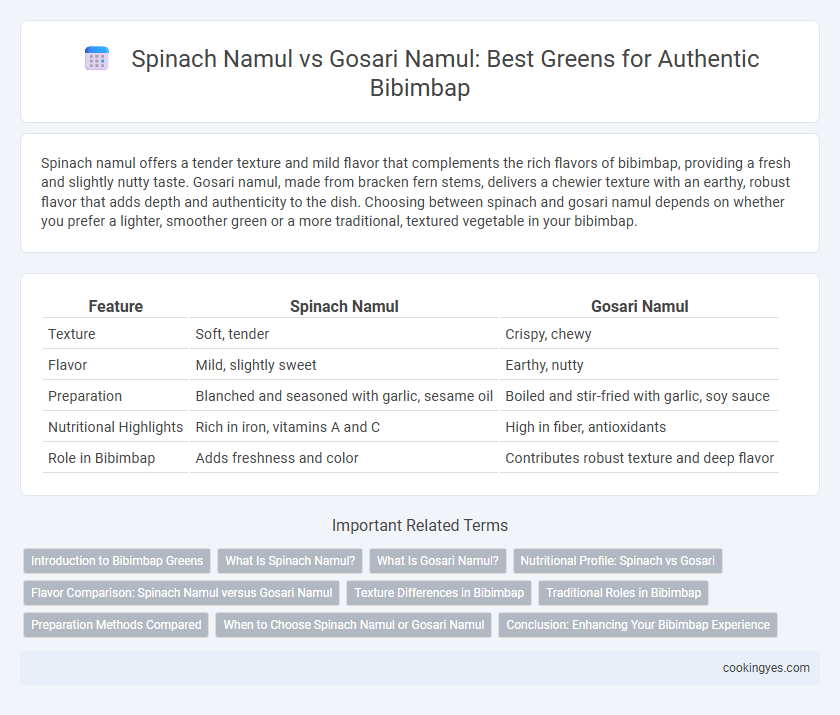Spinach namul offers a tender texture and mild flavor that complements the rich flavors of bibimbap, providing a fresh and slightly nutty taste. Gosari namul, made from bracken fern stems, delivers a chewier texture with an earthy, robust flavor that adds depth and authenticity to the dish. Choosing between spinach and gosari namul depends on whether you prefer a lighter, smoother green or a more traditional, textured vegetable in your bibimbap.
Table of Comparison
| Feature | Spinach Namul | Gosari Namul |
|---|---|---|
| Texture | Soft, tender | Crispy, chewy |
| Flavor | Mild, slightly sweet | Earthy, nutty |
| Preparation | Blanched and seasoned with garlic, sesame oil | Boiled and stir-fried with garlic, soy sauce |
| Nutritional Highlights | Rich in iron, vitamins A and C | High in fiber, antioxidants |
| Role in Bibimbap | Adds freshness and color | Contributes robust texture and deep flavor |
Introduction to Bibimbap Greens
Spinach namul and gosari namul are essential bibimbap greens, each adding distinct flavors and textures to the dish. Spinach namul offers a tender, mild taste and vibrant green color, providing a fresh contrast to the rich bibimbap ingredients. Gosari namul, made from bracken fern, has a chewier texture and earthy, slightly bitter flavor that complements the savory and spicy components of bibimbap.
What Is Spinach Namul?
Spinach namul is a seasoned Korean side dish made from blanched spinach, lightly flavored with sesame oil, garlic, soy sauce, and sesame seeds, commonly used as a fresh and nutritious green ingredient in bibimbap. Compared to gosari namul, which features bracken fern stems and offers a chewier texture, spinach namul provides a tender, mild, and slightly earthy flavor that complements the vibrant mix of bibimbap greens. Its high vitamin content and soft texture make spinach namul a popular choice for balancing the dish's diverse flavors and textures.
What Is Gosari Namul?
Gosari namul is a Korean seasoned fernbrake dish commonly used as one of the vegetable toppings in bibimbap. Unlike spinach namul, which offers a mild and tender texture, gosari namul provides a unique chewy, earthy flavor that adds depth and authenticity to bibimbap greens. Rich in fiber and antioxidants, gosari namul enhances the nutritional profile and traditional taste balance essential to classic bibimbap.
Nutritional Profile: Spinach vs Gosari
Spinach namul offers a rich source of vitamins A, C, and K, along with iron and folate, essential for boosting immunity and promoting healthy blood circulation in bibimbap. Gosari namul, made from bracken fern bristles, provides dietary fiber and antioxidants but contains fewer vitamins than spinach, contributing a unique earthy flavor while supporting digestive health. Choosing between spinach and gosari namul influences the overall nutrient density and flavor profile of bibimbap greens, with spinach delivering higher micronutrient content.
Flavor Comparison: Spinach Namul versus Gosari Namul
Spinach namul offers a mild, slightly sweet flavor with a tender texture that complements the freshness of bibimbap greens, enhancing the overall balance without overpowering other ingredients. Gosari namul, made from bracken fern stems, provides a rich, earthy taste with a chewy consistency that adds depth and a rustic note to the dish. The contrast between spinach's subtle softness and gosari's robust, nutty undertones creates a dynamic flavor profile essential for authentic bibimbap.
Texture Differences in Bibimbap
Spinach namul offers a tender and slightly crisp texture, providing a delicate bite that balances well in Bibimbap. Gosari namul, made from bracken fern shoots, delivers a chewier and more fibrous texture, adding a robust, earthy contrast. The choice between these greens significantly influences the overall mouthfeel, with spinach creating lighter freshness and gosari contributing hearty rusticity.
Traditional Roles in Bibimbap
Spinach namul offers a tender, mild flavor and vibrant green color, traditionally providing a fresh balance in bibimbap's vegetable mix. Gosari namul, made from bracken fern stems, adds a unique earthy, slightly chewy texture that is essential for authentic Korean bibimbap, especially in regions emphasizing mountain vegetables. Both greens contribute distinct textures and flavors, preserving the cultural authenticity and harmony of ingredients crucial to traditional bibimbap.
Preparation Methods Compared
Spinach namul for bibimbap involves blanching fresh spinach briefly, then seasoning it lightly with garlic, sesame oil, and soy sauce, preserving its tender texture and vibrant green color. Gosari namul preparation requires soaking dried bracken fern, boiling to soften, then stir-frying with garlic, soy sauce, and sesame oil, resulting in a chewier, earthier green component. These contrasting preparation methods influence the texture and flavor profile of bibimbap greens, with spinach providing a fresh, mild taste and gosari offering a deeper, nuttier flavor.
When to Choose Spinach Namul or Gosari Namul
Spinach namul offers a tender texture and mild flavor, making it ideal for fresh, light bibimbap varieties or when balancing strong, spicy sauces. Gosari namul, with its earthy, chewy consistency and robust taste, is preferred for more traditional or hearty bibimbap recipes, especially those featuring beef or rich gochujang. Choose spinach namul to enhance vibrant, fresh greens and gosari namul for depth and authenticity in classic Korean bibimbap.
Conclusion: Enhancing Your Bibimbap Experience
Spinach namul offers a tender texture and mild, slightly sweet flavor that balances well with bibimbap's spicy gochujang and savory sesame oil. Gosari namul, with its earthy, chewy fernbrake character, adds a robust, nutty depth that complements the mixed rice's hearty profile. Choosing between spinach and gosari namul depends on whether you prefer a lighter, fresher bite or a rich, textured contrast to elevate your bibimbap experience.
Spinach namul vs Gosari namul for bibimbap greens Infographic

 cookingyes.com
cookingyes.com